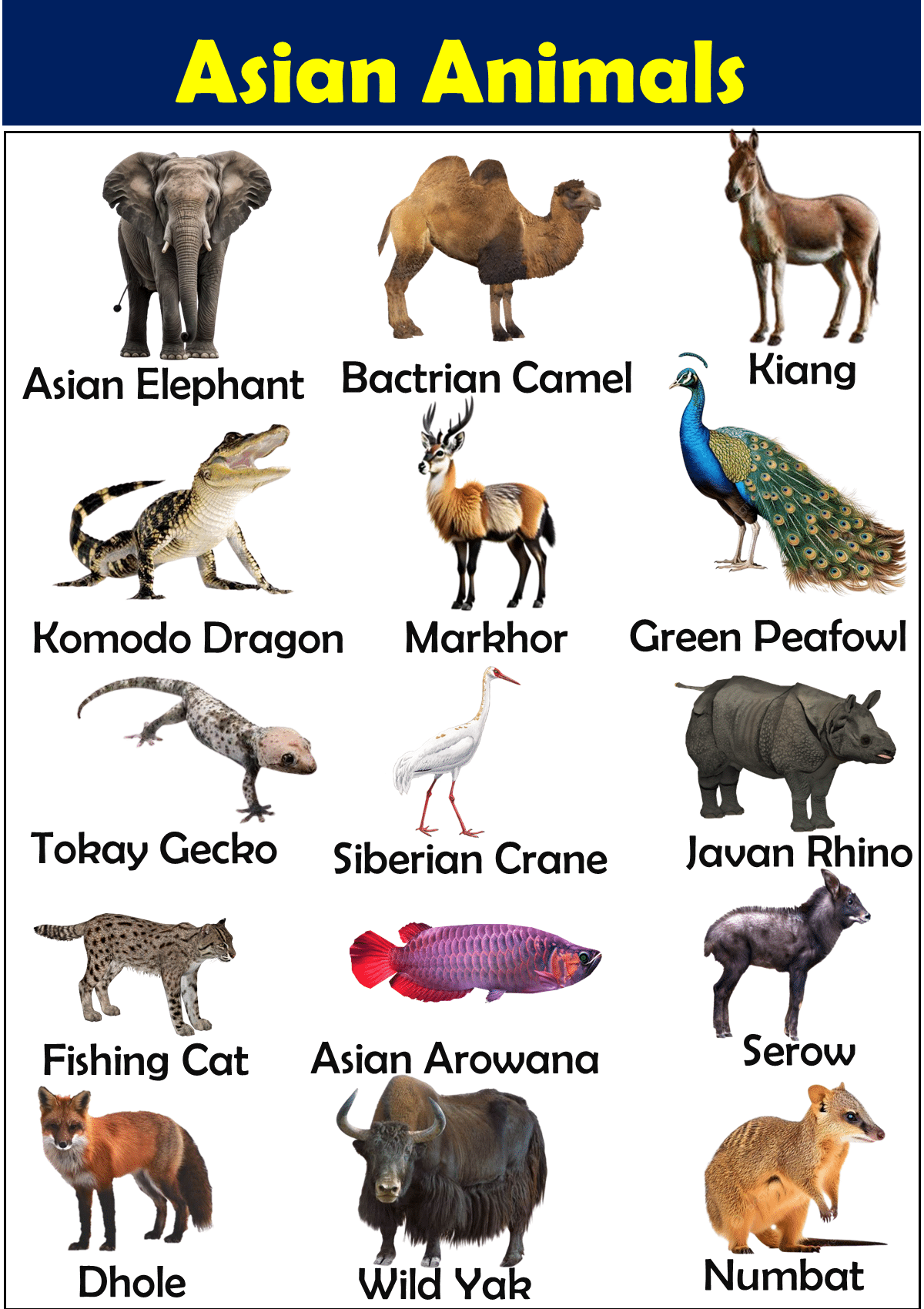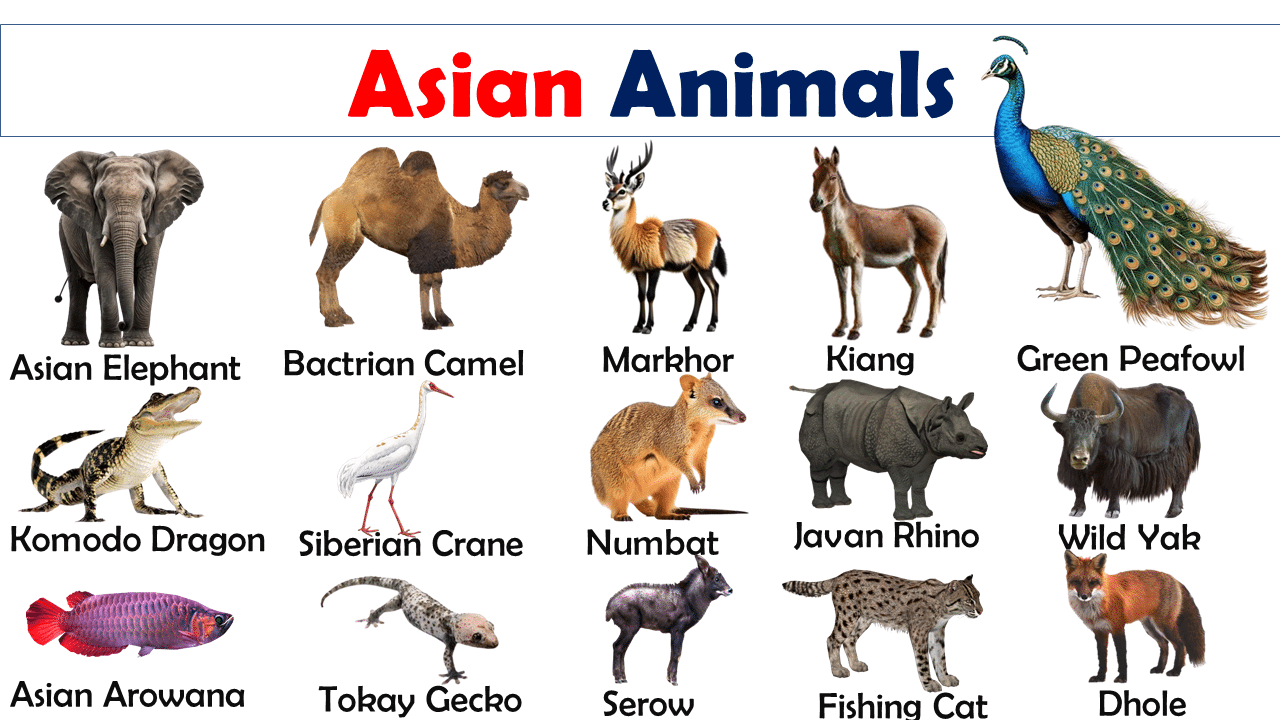Asia is a land of incredible diversity, home to some of the most fascinating animals on the planet. In this blog post, we’ll explore the world of Asian animals, from the majestic Bengal tiger prowling in the jungles to the giant panda munching on bamboo in China. You’ll discover how these animals live, what they eat, and some of the challenges they face in the wild. This exploration will help you learn new English vocabulary related to these extraordinary Asian creatures. Let’s dive into the amazing animal kingdom of Asia!
What are Asian Animals?
Asia, the largest continent on Earth, boasts an incredibly diverse range of habitats, from the dense rainforests of Southeast Asia to the vast deserts of the Middle East and the frozen tundra of Siberia. This diversity creates a habitat for a multitude of unique wildlife, many of which are endemic to specific areas of the continent. Asian animals include not only the well-known giants like the elephant and tiger but also numerous species of birds, reptiles, insects, and marine life.
List of Asian Animals
- Bengal Tiger
- Asian Elephant
- Giant Panda
- Komodo Dragon
- Orangutan
- Indian Rhinoceros
- Snow Leopard
- Bactrian Camel
- Red Panda
- King Cobra
- Asian Black Bear
- Malayan Tapir
- Siberian Crane
- Gaur
- Water Buffalo
- Proboscis Monkey
- Clouded Leopard
- Gharial
- Sun Bear
- Tarsier
- Asian Arowana
- Saiga Antelope
- Asian Lion
- Markhor
- Mongolian Wild Horse (Przewalski’s Horse)
- Slow Loris
- Hornbill
- Flying Fox
- Irrawaddy Dolphin
- Asian Golden Cat
- Indian Peafowl
- Yak
- Himalayan Monal
- Sunda Pangolin
- Dhole
- Tokay Gecko
- Olive Ridley Turtle
- Wild Yak
- Siberian Musk Deer
- Asian Small-Clawed Otter
- Nicobar Pigeon
- Sumatran Rhino
- Langur
- Golden Pheasant
- Crested Ibis
- Philippine Eagle
- Reticulated Python
- Sambar Deer
- Lesser Panda
- Leopard Cat
- Fishing Cat
- Javan Rhino
- Civet
- Chinese Alligator
- Mugger Crocodile
- Japanese Macaque
- Indochinese Tiger
- Green Peafowl
- Asiatic Cheetah
- Serow
- Kiang
- Leaf Monkey
- Spotted Dove
- Mongoose
- Asian Houbara
- Urial
- Chinese Water Deer
- Numbat
- Balinese Starling
- Asian Palm Civet
Explore More Animal Vocab:
Taiga Animals | Freshwater Animals | American Animals

Asian Animals Vocabulary and Their Facts
1. Bengal Tiger
The Bengal tiger is one of the largest and most iconic big cats. Native to India, Bangladesh, Nepal, and Bhutan, this apex predator primarily hunts large ungulates. Its striking orange coat with black stripes is unique to each individual. Conservation efforts are crucial as their numbers are threatened by poaching and habitat loss.
2. Asian Elephant
Larger than its African cousins, the Asian elephant is distinguished by smaller ears and a more humped back. These intelligent creatures form complex matriarchal societies and are revered in many Asian cultures. Habitat encroachment and poaching for ivory and skin are significant threats to their survival.
3. Giant Panda
Known worldwide as a symbol of conservation, the giant panda is native to China’s mountainous regions. It primarily feeds on bamboo and plays a crucial role in its habitat’s ecology. Conservation efforts have helped increase their numbers, though their habitat remains fragmented.
4. Komodo Dragon
The world’s largest lizard, the Komodo dragon, can be found in Indonesia’s Komodo National Park. These predators are capable of killing prey as large as deer with their powerful bite, which contains venomous proteins.
5. Orangutan
Native to the rainforests of Borneo and Sumatra, orangutans are known for their distinctive red fur and high intelligence. They spend most of their lives in trees and are critically endangered due to habitat destruction and illegal trade.
6. Indian Rhinoceros
The Indian rhinoceros, or the greater one-horned rhinoceros, is known for its single black horn and armor-like skin folds. It is mainly found in northern India and Nepal. Conservation programs have helped improve their numbers, yet poaching remains a threat.
7. Snow Leopard
This elusive big cat inhabits the high mountain ranges of Central Asia. Known for its beautiful fur and incredible agility in rocky terrains, the snow leopard is a vital predator in its ecosystem. It remains endangered due to poaching and habitat loss.
8. Bactrian Camel
Adapted to life in Central Asia’s harsh deserts, the Bactrian camel has two humps, unlike its Middle Eastern relatives. It can survive temperatures from freezing cold to blistering heat and go for months without water.
9. Red Panda
Much smaller than the giant panda, the red panda is found in the temperate forests of the Himalayas. With striking red fur and a long shaggy tail, it spends most of its time in trees and is threatened by deforestation and poaching.
10. King Cobra
The king cobra is the world’s longest venomous snake, found predominantly in forests from India to Southeast Asia. It primarily feeds on other snakes and is revered in many cultural folklore and myths.
11. Asian Black Bear
Also known as the moon bear because of the white crescent marking on its chest, the Asian black bear is found in forests across Asia. It is omnivorous and can be aggressive if threatened.
12. Malayan Tapir
The Malayan tapir, distinguished by its distinctive black and white coloring, is one of the few surviving members of the tapir family. Found in the rainforests of Southeast Asia, it is mostly nocturnal and has a diet consisting primarily of plant material.
13. Siberian Crane
This critically endangered bird migrates thousands of kilometers from northern Russia to India and China for the winter. It is distinguished by its pure white feathers and red face patch.
14. Gaur
The gaur is the largest species of wild cattle, found in the forests of South and Southeast Asia. It is a strong and massively built species with a high dorsal ridge and a dark brown coat.
15. Water Buffalo
Essential to rural agriculture in Asia, especially in places like India, China, and Southeast Asia, the water buffalo is used for plowing and other forms of labor. It is also a source of milk, meat, and hide.
16. Proboscis Monkey
Known for its large nose and pot-bellied appearance, the proboscis monkey is endemic to the mangrove forests of Borneo. This primate is a strong swimmer and feeds primarily on leaves and fruit.
17. Clouded Leopard
Named for its distinctive “cloud” patterned coat, the clouded leopard is a medium-sized cat native to the Himalayan foothills. It is one of the best climbers among the big cats and preys on a variety of arboreal and ground-dwelling species.
18. Gharial
With its long, narrow snout, the gharial is specialized for catching fish, its primary diet. Found in the river systems of the Indian Subcontinent, it is one of the largest crocodiles and is critically endangered.
19. Sun Bear
The sun bear, the smallest member of the bear family, is found in Southeast Asian tropical forests. It gets its name from the crescent-shaped patch on its chest. The sun bear is known for its extremely long tongue, used for extracting honey from beehives.
20. Tarsier
Tarsiers are small primates with enormous eyes, each of which weighs more than the brain. Found in the islands of Southeast Asia, they are nocturnal and primarily insectivorous.
21. Asian Arowana
Often called the “dragon fish” in parts of Asia due to its scales that resemble dragon scales, the Asian arowana is a freshwater fish popular in the aquarium trade for its striking appearance and supposed good luck.
22. Saiga Antelope
Characterized by its unusual, oversized, flexible nose structure, the Saiga antelope roams the arid landscapes of Central Asia. It is critically endangered due to poaching and habitat loss.
23. Asian Lion
Smaller than its African counterpart, the Asian lion has a more prominent mane and a smaller body size. Today, it survives in the wild only in India’s Gir Forest, with fewer than 500 individuals remaining.
24. Markhor
The markhor is a wild goat known for its impressive, twisted horns. It is found in the mountains of Central Asia and the Himalayas, where it climbs steep rocky terrains with ease.
25. Mongolian Wild Horse
Also known as Przewalski’s horse, this is the only truly wild horse species remaining in the world today. Found in Mongolia, these horses have never been domesticated and are known for their sturdy build and pale yellow coat.
26. Slow Loris
The slow loris is a group of several species of nocturnal primates from Southeast Asia. They have a round face, big eyes, and a venomous bite, a rare trait among mammals.
27. Hornbill
Hornbills are birds known for their long, down-curved bill which is frequently brightly colored and sometimes has a casque on the upper mandible. They are found throughout Asia, primarily in tropical forests.
28. Flying Fox
The flying fox is a large species of bat that feeds primarily on fruit. It is named for its fox-like face and large wingspan, which can reach more than 1.5 meters.
29. Irrawaddy Dolphin
This dolphin species is found in coastal areas and rivers of South and Southeast Asia. It is known for its bulging forehead and short beak, and is critically endangered due to habitat loss and fishing practices.
30. Asian Golden Cat
The Asian golden cat is a medium-sized wild cat of Southeast Asia. It is adaptable to various environments but prefers forest habitats. It can vary significantly in color, ranging from golden to dark brown.
